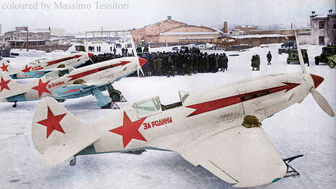Original design of the Mig-1, a fast interceptor which only 100 were produced to be very difficult to maneuver, the Mig-3 has remedied some of

the problems, entering service in 1941, staying in operation by the end of the conflict with 3322 produced . Very easy to repair, was an excellent high-altitude interceptor, despite having been a model for ground attack, not very successful due to the engine, designed for operation at high altitudes.
Development[]
Mikoyan and Gurevich made a number of modifications to the design of the MiG-1 after tests in the wind tunnel T-1 Central Air and Hydrodynamic Institute (TsAGI). All changes were made within the manufacturing plant.
These changes included:
- Forward 4 inches (101 mm) the engine, giving him more stability.
- Increase the internal angle of the dihedral an extent, which also increased its stability.
- Add a new radiator (OP-310), which allowed to load additional fuel tank of 250 liters
- Addition of an oil tank under the engine.
- Venting of exhaust gases within the fuel tanks to reduce the likelihood of fire on impact of enemy fire.
- Add an 8mm armor after the pilot (later increased to 9mm).
- Streamlining the turbocharger.
- Confirming the main landing gear.
- Increase the size of the main wheels up to 650mm x 200mm.
- Improve the dome, which improved the rear view of the pilot, and also allowed the installation of a radio RSI-1 after the pilot (subsequently increased to a RSI-4).
- Redesigning the instrument panel.
- Improving the view of weapons of PBP-1 to PBP-1 ª.
- Increase the supply of ammunition for the gun ShKAS up to 750 rounds per gun.
- Additional points under its wings, enabling it to carry 220 kg under the wings of pumps, spray containers or eight unguided rockets RS-82.
The first aircraft to see these changes, was the I-200 No.04, which was the fourth prototype of the I-200, which was completed by converting the MiG-1. which flew for the first time in late October 1940. Following the success of its first flight, became the Soviet Air Force for its official test.
During testing, the NKAP (Ministry of the Aviation Industry People) announced that three factories, would build the MiG-3, which required a total of 3,600 aircraft built 1941.
Operational History[]

MIG-3 with winter painting
The first MiG-3 series, left the production line December 20 of 1940. In March 1941, 10 of these devices out of the factories each day. At the time of Operation Barbarossa, Had produced more than 1,200 MiG-3.
During initial tests, the plane was found below the MiG-1 due to increased weight and higher fuel consumption as they had warned Mikoyan and Gurevich from the factory number 24, but the fuel consumption is actually found suitable when it detected a fault in the altitude correction.
However, this was not the last edition that saw the MiG-3 for its deployment. Some MiG-3 produced, they found unacceptable behavior at altitude, due to fuel pressure and oil. We also found that some drivers were trying to fly the MiG-3 as if the former fighters (especially the Polikarpov I-15, I-153 and I-16.) Introduced new fuel pumps and oil, and training was attempted to familiarize pilots with the MiG-3.
In the next two years, the MiG-3, underwent some further changes, including increasing their cannons and machine guns.
Due to the conditions of battle against German forces, the MiG-3 was forced to fight at low altitude, even in ground attack roles, although in this paper, much less met him, so he left to play. Death for the MiG-3 came with the cessation of production of engines AM-35A as Mikulin focused on the new AM-38 produced for the Ilyushin Il-2 Shturmovik. Functions continued to be used for reconnaissance, where its service ceiling, 40,000 feet near its high speed and altitude, made him suitable for this role.
Despite the limitations of the MiG-3 Alexander 'Sasha' Pokryshkin, Was the second fighter ace with 59 victories Soviet aviation officials reported, many of which were at the controls of a MiG-3.
Variants[]
During the remainder of the war, Mikoyan and Gurevich continued to develop the MiG-3 as high-altitude interceptor, as originally had been designed, prototypes and other larger and more powerful, designated with the names I-220 until I-225 (Some sources, incorrectly assigned the designation MiG-7 to one of these aircraft.). "Meanwhile, the war against Germany, showed that the time of the game powered by piston engines, had come to an end, so no order for production order came to take
There were some attempts engined plane with AM-37. This unit was designated as MiG-7But with the cessation of production of these engines, the project was canceled. Since spring 1942 the MiG-3 was displaced from the front, the air defense squadrons, some of whom flew with them the rest of the war.
- MiG-3: Fighter Interceptor car, with a Mikulin AM-35A engine 1,350-hp. (1007-kW).
- I-210: Prototype of the MiG-3 with a radial engine Shvetsov ASh-82, Also known as MiG-3-82.
- I-211: Prototype of the MiG-3 with Shvetsov radial engine.
- MiG-3U: Prototype version of the MiG-3 derived from the same engine
Specifications[]
- Length: 8.26 m

MIG-3's Engine
- Height: 3.5 m
- Wingspan: 10.2 m
- Wing surface: 17.44 m2
- Weight: 2699 kg (empty) 3350 kg (maximum)
- Engine: An on-line 12-cylinder, water cooled, AM-35 (1,350 hp at takeoff)
- Speed: 505 km / h (maximum, at 0 m), 640 km / h (maximum at 7800 m)
- Ceiling: 12,000 m
- Autonomy: 1250 km
- Armament: 1 12.7 mm machine gun UBS, two machine guns ShKAS 7.62 mm, 400 kg bombs or 200 kg bombs and six rockets 82mm
- Crew: 1
The original article can be found at Mikoyan MiG-3 and the edit history here.